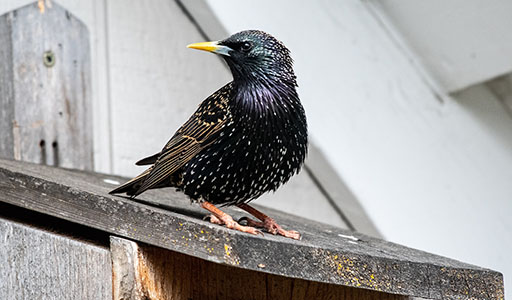Starlings

Starling Information
Starlings are an invasive species with a strong presence, totaling over 150 million birds. They live mainly in urban settings and flock in large numbers, which causes various problems for crops.
Starlings typically have dark blue and black feathers with spots and orange feet. In the wild, starlings are excellent at mimicking sounds that they hear in nature and the calls of other birds.
Starlings feed off of vegetation, potentially destroying your landscaping and gardens. Excessive starling defecation can damage building materials. Most commonly, starlings will build nests in your home’s attic or vents. These nests are constructed of grasses, weeds, and leaves and are the resting place for starling’s and their eggs.

What does a Starling look like?
At approximately eight and a half inches long and three ounces in weight, starlings are small to medium sized birds. Although they may look black from a distance, up close their feathers shine iridescent green or purple. The pests have reddish-brown legs and black beaks that turn yellow during mating season. Male starlings can be identified by the elongated feathers over their chests, while females have shorter plumes.

What does a Starling eat?
This omnivorous species feeds on a variety of animals and plants. Spiders, moths, centipedes, and earthworms are common food sources, as are berries, seeds, apples, pears, plums, and cherries. Diet varies with both age and availability. While young starlings eat mostly animal protein, adults feed primarily on plants.

Where do starlings live?
Starlings are found everywhere from cities to farms and from parks to fields. The pests use holes in trees, building crevices, and bird houses for their nests, filling them with loose sticks, grass, leaves, and feathers. Because of starlings’ sheer numbers and aggressive temperament, they often drive out or even kill other cavity-nesting birds. This has resulted in population declines for some wrens, swallows, and bluebirds.


